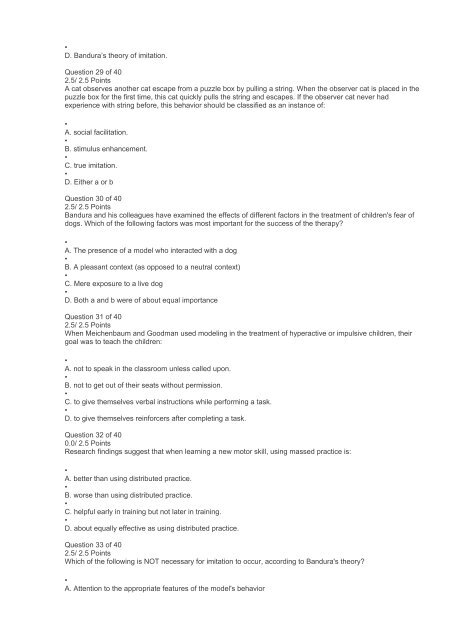PS420 Learning Theories Exam 7 Part 2 Answers (Ashworth College)
You also want an ePaper? Increase the reach of your titles
YUMPU automatically turns print PDFs into web optimized ePapers that Google loves.
•<br />
D. Bandura’s theory of imitation.<br />
Question 29 of 40<br />
2.5/ 2.5 Points<br />
A cat observes another cat escape from a puzzle box by pulling a string. When the observer cat is placed in the<br />
puzzle box for the first time, this cat quickly pulls the string and escapes. If the observer cat never had<br />
experience with string before, this behavior should be classified as an instance of:<br />
•<br />
A. social facilitation.<br />
•<br />
B. stimulus enhancement.<br />
•<br />
C. true imitation.<br />
•<br />
D. Either a or b<br />
Question 30 of 40<br />
2.5/ 2.5 Points<br />
Bandura and his colleagues have examined the effects of different factors in the treatment of children's fear of<br />
dogs. Which of the following factors was most important for the success of the therapy?<br />
•<br />
A. The presence of a model who interacted with a dog<br />
•<br />
B. A pleasant context (as opposed to a neutral context)<br />
•<br />
C. Mere exposure to a live dog<br />
•<br />
D. Both a and b were of about equal importance<br />
Question 31 of 40<br />
2.5/ 2.5 Points<br />
When Meichenbaum and Goodman used modeling in the treatment of hyperactive or impulsive children, their<br />
goal was to teach the children:<br />
•<br />
A. not to speak in the classroom unless called upon.<br />
•<br />
B. not to get out of their seats without permission.<br />
•<br />
C. to give themselves verbal instructions while performing a task.<br />
•<br />
D. to give themselves reinforcers after completing a task.<br />
Question 32 of 40<br />
0.0/ 2.5 Points<br />
Research findings suggest that when learning a new motor skill, using massed practice is:<br />
•<br />
A. better than using distributed practice.<br />
•<br />
B. worse than using distributed practice.<br />
•<br />
C. helpful early in training but not later in training.<br />
•<br />
D. about equally effective as using distributed practice.<br />
Question 33 of 40<br />
2.5/ 2.5 Points<br />
Which of the following is NOT necessary for imitation to occur, according to Bandura's theory?<br />
•<br />
A. Attention to the appropriate features of the model's behavior

















